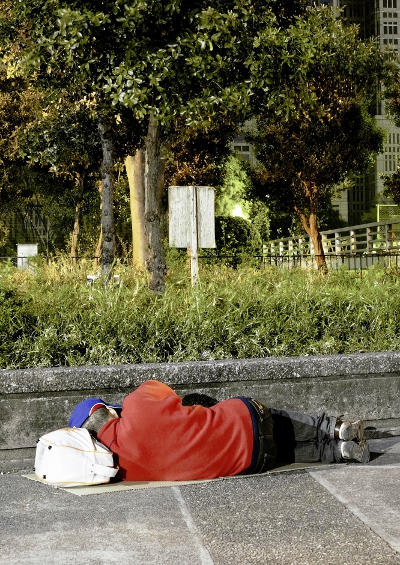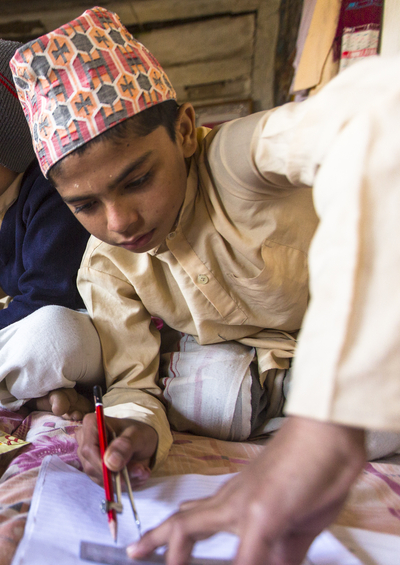The Homeless in Tokyo: An Understated Issue
Homeless people in Tokyo number more than the government wants to admit and sleep in the shadow of City Hall.
December 13, 2014

Based in Hamburg, Germany, Samuel Zuder works on commission for international magazines, advertising agencies and other businesses. He also exhibits his own works focused on Asia that have made it into museums and Galleries all over the world.
At the heart of central Tokyo’s Shinjuku district stands the 235-meter-high Tokyo City Hall, one of the city’s most famous buildings, designed by star architect Kenzo Tange and home to the Tokyo metropolitan government. Every morning, as hundreds of suited officials enter its doors, another local community sets off on its daily commute.
From Shinjuku Central Park, literally in the shadow of City Hall, a community of homeless people dismantle their shelters made of blue plastic sheeting and cardboard, pack them and their other belongings into trolleys and head off to their work – collecting plastic bottles from around the district.
Every evening, after a hard day’s work, these communities pass each other again. As the homeless return to put up their temporary shelters for the night, the formally dressed bureaucrats hurry through the park to Shinjuku station and the trains that will take them back to their homes and families in the Tokyo suburbs.
In the mid-1990s, the city government tried to banish the homeless from the district. Their efforts failed as it proved impossible to stop people returning each night to sleep wherever they could find a spot to lie down. Officials have been more tolerant since, accepting that while office workers can relax and eat their lunch in the park during the day, at night it belongs to those with no homes.
Text and photographs by Samuel Zuder
 Enlarge Beside the main street outside Shinjuku Central Park, a man sleeps, oblivious to traffic and the all-night glare of street lighting.
Enlarge Beside the main street outside Shinjuku Central Park, a man sleeps, oblivious to traffic and the all-night glare of street lighting. Enlarge A homeless man eats dinner next to his shelter. Officials put Tokyo’s homeless population at around 3,400 and Japan’s at 16,000 (aid groups put the national total much higher, at 25,000-50,000). More than 90% of these people are single men and most are over 50.
Enlarge A homeless man eats dinner next to his shelter. Officials put Tokyo’s homeless population at around 3,400 and Japan’s at 16,000 (aid groups put the national total much higher, at 25,000-50,000). More than 90% of these people are single men and most are over 50. Enlarge A man sleeping on the steps.
Enlarge A man sleeping on the steps. Enlarge A woman learning english by watching sesam-street on her portable T.V. phone.
Enlarge A woman learning english by watching sesam-street on her portable T.V. phone. Enlarge Yamamoto-san has lived for more than 4 years in his box at the main entrance of the park.
Enlarge Yamamoto-san has lived for more than 4 years in his box at the main entrance of the park. Based in Hamburg, Germany Samuel Zuder works on commission for international magazines, advertising agencies and other businesses. He also exhibits his own works focused on Asia, that have made it into museums and Galleries all over the world.
Based in Hamburg, Germany Samuel Zuder works on commission for international magazines, advertising agencies and other businesses. He also exhibits his own works focused on Asia, that have made it into museums and Galleries all over the world.The Other Hundred is a unique photo-book project (order here) aimed as a counterpoint to the Forbes 100 and other media rich lists by telling the stories of people around the world who are not rich but who deserve to be celebrated.
Its 100 photo-stories move beyond the stereotypes and cliches that fill so much of the world’s media to explore the lives of people whose aspirations and achievements are at least as noteworthy as any member of the world’s richest 1,000.
 Selected from 11,000 images shot in 158 countries and submitted by nearly 1,500 photographers, The Other Hundred celebrates those who will never find themselves on the world’s rich lists or celebrity websites.
Selected from 11,000 images shot in 158 countries and submitted by nearly 1,500 photographers, The Other Hundred celebrates those who will never find themselves on the world’s rich lists or celebrity websites.